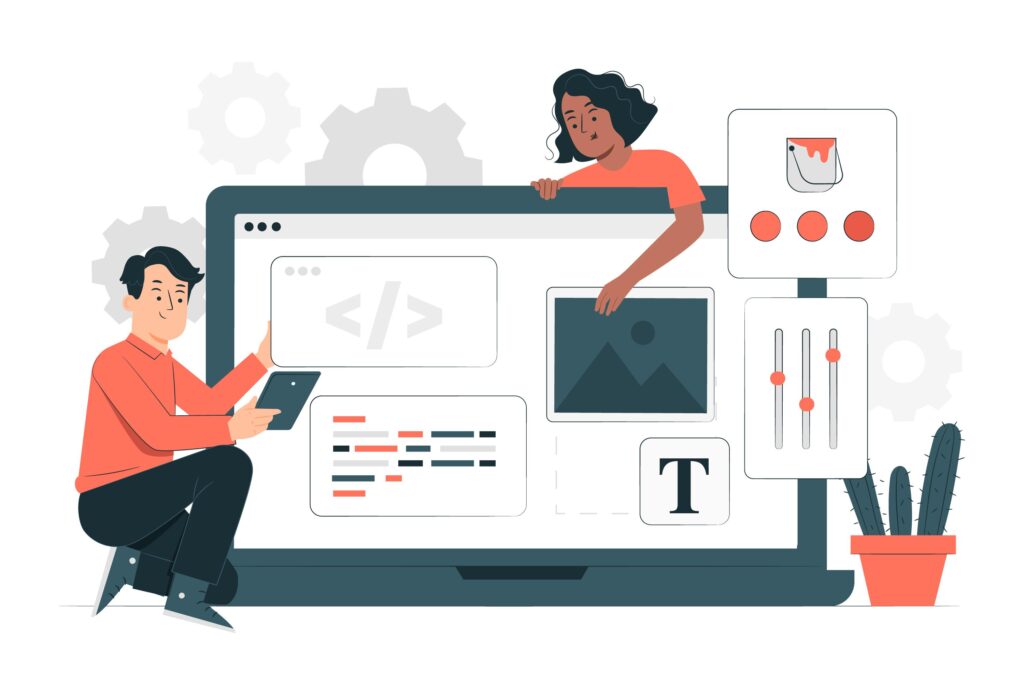1. Introduction
In 2025 and beyond, small businesses face an overcrowded and ever-evolving online environment. The web is saturated with templated, look-alike sites, making it increasingly challenging to stand out. Yet, those who invest in a custom website—tailored to their brand identity, marketing objectives, and user experience—can break through the clutter.
A custom website is more than an online brochure. Done right, it becomes a dynamic tool that merges:
• Design (visual appeal, branding, and layout)
• Marketing (branding strategy, funnel alignment, lead generation)
• Development (functionality, speed, scalability, and security)
• SEO (search engine optimization for top visibility on Google, Bing, Yahoo, and Yandex)
This article delves into the five key benefits of opting for a custom site—covering everything from brand differentiation and flexibility to SEO gains and long-term ROI. We’ll map these benefits to the client awareness funnel, ensuring you can address prospects effectively whether they’re unaware of their web design needs or fully aware and ready to buy. Additionally, we’ll discuss how ready-made website solutions from agencies like Nveil can fit into the mix, offering SMBs a route to a custom look without breaking the bank.
Who Should Read This?
• SMB owners suspecting their current site is underperforming
• Marketing managers evaluating a website overhaul
• Development teams exploring synergy between front-end design and back-end flexibility
• Entrepreneurs launching new ventures, weighing custom vs. ready-made solutions
If your goal is to dominate SERPs, build brand credibility, and future-proof your online presence, read on.
2. Understanding the Concept of a “Custom Website” for SMBs
A custom website doesn’t rely on a cookie-cutter theme or generic templates. Instead, it’s built (or heavily modified) to reflect your brand personality, target audience, and business objectives. This can range from a fully bespoke design coded from scratch to a significantly tweaked template-based platform that still captures your unique look and feel.
Key elements often include:
• Tailored Layouts: Reflecting user behaviors, brand identity, and conversion funnels
• Unique Branding: Consistent logos, colors, and typography that differentiate you
• Marketing Integration: Lead capture forms, e-commerce modules, or automation workflows
• Scalable Architecture: Allows easy feature additions without rebuilding the whole site
Unlike off-the-shelf solutions, custom sites adapt to your SMB’s evolving needs, helping maintain a competitive edge as you scale.
3. The 5 Key Benefits of Custom Websites
Let’s dissect five major advantages that a custom site offers small businesses. Consider these essential guidelines to determine if fully bespoke or a hybrid approach is right for you.
3.1 Branding and Uniqueness
High-Traffic Keywords: “Brand consulting,” “digital marketing company,” “web design agency”
Why It Matters
• With users bombarded by countless online stimuli, your brand’s visual and narrative identity becomes vital for recognition.
• Generic themes often fail to convey your brand’s unique ethos.
Custom websites:
• Showcase brand ethos: From color palettes to microcopy, everything mirrors your brand tone.
• Differentiate from competitors: A distinctive look can be the tipping point for prospective clients.
• Reinforce trust: Cohesive design across digital channels builds credibility.
Example: A local craft brewery might need a rustic, earthy site to reflect artisanal vibes—something a generic theme can’t fully capture.
3.2 Flexibility and Scalability
Moderate-Competition Keywords: “Ready-made websites for small businesses,” “affordable website solutions,” “conversion optimization tips”
Why It Matters
• Business requirements evolve. You may want advanced analytics, new product lines, or membership features.
Custom builds:
• Add features seamlessly: Expand without a total site rebuild.
• Integrate specialized tools: CRMs, marketing platforms, or unique APIs become easier to embed.
• Performance Tuning: Custom code lets you optimize loading times and security more thoroughly.
Example: A business might begin with a blog and lead forms, then add e-commerce or advanced CRM integrations later. Custom setups handle growth seamlessly.
3.3 SEO Advantages and Higher Visibility
High-Competition Keywords: “SEO services,” “digital marketing company,” “responsive design”
Why It Matters
• Technical excellence plus unique content fosters strong SEO. Custom sites let you implement specialized structures, schemas, and load-time optimizations right from the start.
Custom websites:
• Leverage schema markup: (e.g., local business, product reviews) for enhanced SERP visibility.
• Optimize architecture: Logical navigation ensures quick, efficient crawling by search engines.
• Improve load times: Clean, modular code speeds up pages, indirectly boosting rank.
Example: Ranking for “responsive design” or “SEO services” demands meticulous on-page optimization—a custom site structure accommodates that with minimal conflict.
3.4 Enhanced User Experience (UX) and Conversions
Moderate-Competition Keywords: “conversion optimization tips,” “local SEO strategies”
Why It Matters
• UX integrates design, marketing, and development to guide visitors fluidly from curiosity to completion.
Custom sites:
• Lower bounce rates: Users find info quickly and stay longer.
• Boosted conversion: Strategic CTAs, well-structured forms, or user-tailored interactions encourage sign-ups or sales.
• Emotional engagement: A brand-specific look/feel fosters loyalty and repeat visits.
Example: A local boutique might embed an interactive “lookbook” that resonates with a style-savvy audience. Generic templates might lack such specialized features.
3.5 Long-Term ROI and Future-Readiness
High-Traffic Keywords: “web design agency,” “responsive design”
Why It Matters
• Though custom sites can cost more upfront, they typically yield higher ROI, thanks to their adaptability and lower long-term technical debt.
Benefits:
• Reduced technical debt: Clean, modular code avoids patchwork fixes.
• Brand evolution: Easily re-skin or pivot your site if you rebrand or add new lines.
• Scalable growth: Handle more traffic or expanded services without a total rebuild.
Example: A small local store might later expand globally; with a custom framework, it can add multi-currency checkouts, advanced shipping rules, or new language pages without starting over.
4. Aligning Custom Website Benefits with the Client Awareness Funnel
Custom websites directly influence how visitors progress through your funnel—from not realizing they need improvements (TOFU) to being fully aware (BOFU) and ready to act.
4.1 Unaware & Problem-Aware (Top of Funnel – TOFU)
User State: May not grasp the importance of a custom site; they just know their current setup isn’t ideal.
Content Approach: Blog posts on “Why Generic Themes Undermine Your Brand” or “The Hidden Costs of Cheap Templates.”
Design Angle: Eye-catching hero images, approachable layout, subtle CTA invites to learn more.
Custom Benefit: A unique look that instantly stands out, drawing curiosity.
4.2 Solution-Aware (Middle of Funnel – MOFU)
User State: They know custom websites exist but haven’t decided who to hire.
Content Approach: Case studies or e-books highlighting ROI from custom builds, integrated SEO strategies.
Design Angle: Detailed pages with process breakdowns, value propositions, and micro-interactions that reveal deeper brand expertise.
Custom Benefit: Show specialized features or success metrics—templated sites can’t match the same level of personalization or brand synergy.
4.3 Product-Aware & Most Aware (Bottom of Funnel – BOFU)
User State: Ready to pick an agency or solution, seeking final validation.
Content Approach: Pricing structures, free consultations, discount codes, or CTA-labeled forms.
Design Angle: Minimal friction, trust seals, straightforward sign-up processes.
Custom Benefit: Trust-building design elements, personalized CTAs, and secure, fast checkout or contact forms that push them to convert.
5. Integrating Design, Marketing, and Development for Maximum Impact
A custom website thrives when design, marketing, and development function harmoniously:
• Design ensures brand identity, user flows, and aesthetics remain consistent.
• Marketing drives funnel strategy, SEO focus, and content creation.
• Development provides technical foundations—performance, security, scalability.
This synergy means your site appeals visually, ranks well, and delivers an intuitive, frictionless UX, from homepage to checkout.
Tip: Neglecting one area—like ignoring on-page SEO or performance—can derail user engagement despite having beautiful visuals or strong marketing copy.
6. Considering Ready-Made Website Solutions: Balancing Custom and Cost
While fully bespoke websites often deliver unmatched flexibility, ready-made solutions offer a stepping stone for SMBs constrained by time or budget.
6.1 Benefits of Ready-Made Solutions
• Speed to Market: Quick deployment saves months.
• Lower Upfront Costs: Economical compared to custom builds.
• Proven Frameworks: Often come SEO-ready, mobile-friendly, with optional e-commerce add-ons.
6.2 Hybrid Approaches
• Semi-Custom: Some agencies, like Nveil, offer “base templates” extensively modified for a branded finish.
• Scalability: Start with essential features, add advanced modules (CRM, membership) later.
6.3 SEO and Branding within Ready-Made Frameworks
• Brand Integration: Adjust colors, fonts, visuals to match your identity.
• Flexible SEO Fields: Good solutions let you edit meta tags, alt attributes, and schemas.
• Scalable: Typically you can install premium plugins or modules for chatbots, funnel tracking, or advanced analytics.
Decision Factor: If you want the best of both worlds—cost efficiency plus strong brand customization—a hybrid ready-made approach might be perfect.
7. High-Traffic vs. Moderate-Competition Keywords for SMB Websites
Selecting keywords ensures your custom site ranks for terms that funnel relevant traffic.
7.1 High-Traffic Keywords
• Web design agency
• SEO services
• Digital marketing company
• Responsive design
7.2 Moderate-Competition Keywords
• Ready-made websites for small businesses
• Affordable website solutions
• Local SEO strategies
• Conversion optimization tips
Targeting both categories helps cover wide visibility (high-competition) and more immediate, targeted traffic (moderate-competition). Utilize long-tail variations (“How to choose the best custom website agency for SMBs”) to catch niche searchers.
8. Case Study: How One SMB Achieved a Breakthrough with Custom Website Features
Scenario: “Urban Craft Apparel,” a niche clothing brand, was overshadowed by mainstream retailers online. Their old site was a hacked-together template lacking brand identity, performance optimization, and SEO focus.
8.1 The Overhaul
• Custom Redesign: Emphasized edgy visuals reflecting their urban style, strong color contrast, and bold typography.
• Site Speed Improvements: Compressed large photos, minified scripts, upgraded hosting servers.
• Integrated CTA Blocks: “Shop Now,” “Get a Custom Design,” “Join Our Newsletter.”
• Funnel-Centric Content: Blog posts on “Urban Street Fashion Tips,” e-book lead magnet for new sign-ups.
• SEO Focus: Balanced moderate-competition phrases (“affordable website solutions,” “urban streetwear tips”) with aspirational high-competition terms (“digital marketing company” to show brand synergy knowledge).
8.2 The Results
• 40% Sales Increase: Within three months, thanks to a streamlined checkout and distinct brand flair.
• Improved Search Ranking: Jumped from page 3 to page 1 for “urban streetwear for small businesses.”
• Enhanced Brand Perception: Loyal customers praised the “unique feel” versus template-like competitors.
Key Insight: Leveraging custom design elements, optimized load times, and funnel-oriented content can spark an SMB’s online growth trajectory, even in crowded niches.
9. Common Pitfalls and How to Avoid Them
Overly Complex Features
Tons of pop-ups or fancy animations can irritate users.
Solution: Keep features focused on user needs and funnel stages.
Ignoring Maintenance
Failure to update code, plugins, or security protocols leads to breaks or vulnerabilities.
Solution: Schedule routine site checks, performance tests, and backups.
Lack of Funnel Strategy
Without mapping user content to TOFU, MOFU, BOFU, your CTAs might feel random.
Solution: Create funnel-focused pages and direct relevant traffic accordingly.
Forgetting Mobile or Accessibility
Non-responsive designs or no alt tags for images alienate visitors and harm SERPs.
Solution: Follow mobile-first principles and WCAG guidelines for inclusive design.
Inconsistent Branding
Slapping a new color scheme on random pages or inconsistent typography breaks brand unity.
Solution: Develop brand guidelines and ensure all pages adhere to them.
10. Conclusion
As the digital marketplace grows more saturated, custom websites stand out by interweaving your SMB’s unique identity with strategic design, marketing, and development. These sites aren’t mere templates—they’re engines for brand differentiation, flexible scalability, SEO dominance, enhanced user experience, and measurable long-term ROI.
By mapping each element of your site to the client awareness funnel (TOFU, MOFU, BOFU), you ensure visitors receive the right messages and CTAs at each stage—guiding them from initial discovery to final purchase. For SMBs balancing cost and customization, ready-made website solutions from agencies like Nveil can provide a halfway point: rapid deployment with a strong foundation for future expansions.
Ultimately, a well-executed custom site future-proofs your online presence. It enables you to adapt quickly to shifting consumer behaviors and search engine algorithms, all while delivering a memorable, conversion-focused user experience. By investing in a site that reflects your brand values and marketing goals—and staying vigilant with updates and analytics—you’ll secure a coveted spot in the digital landscape, achieving growth, loyalty, and a formidable SERP footprint in 2025 and beyond.



